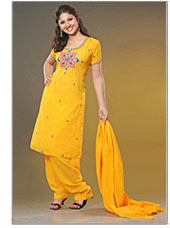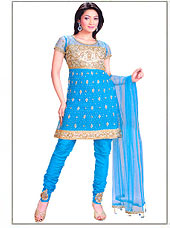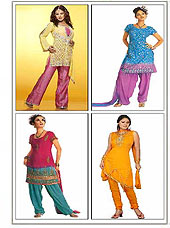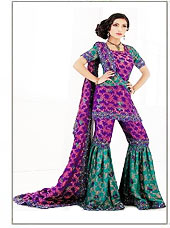









Ladies Tailoring Mart Fashion Fortress For Female Chudithar,Blouse stitching,Aariwork,Embroidery,Stonework,Zardoshi and all type of ladies dresses stitching.
Salwar Kameez Suits:
Salwar Kameez is a traditional outfit worn both in India and Pakistan. It is the national dress in Pakistan. The word salwar is called as shalwar in Pakistan. It is also popular among women in India. The salwar kameez, or salwar suit consists of a kameez (shirt), salwar (trousers) and dopatta (scraf).
SALWAR: Salwar is a sort of loose pajama like trouser. The legs are wide at the top, and narrow at the bottom. There is a drawstring at the top of the waistband to hold up the salwar. The pants can be wide and baggy, or they can be cut quite narrow, on the bias. In the latter case, they are known as churidar pajama.
KAMEEZ: The kameez, in salwar kameez suit, is a long shirt or tunic. The side seams are left open below the navel, which gives the wearer greater freedom of movement. The word kameez is derived from the Latin camisia (shirt or tunic), from which it probably made its way into various European languages (see chemise) and also into Arabic, the likely immediate source for kameez. The kameez is usually cut straight and flat.
DUPATTA: When women wear the salwar kameez, they usually wear a long scarf or shawl called a dupatta around the head or neck. For Muslim women, the dupatta is an alternate to scarves. The dupatta is useful when the head must be covered, for hijab or for prayers.
For most women, the dupatta is simply a stylish accessory that can be worn over one shoulder or draped around the chest and over both shoulders.
In Pakistan and India, one can simply visit the local clothing store or local tailor and has a salwar kameez suit made to order. People outside India and Pakistan can order custom salwar kameez suits over the net. One can select the fabric, indicate the style features desired (type of pants, neckline style, embroidery or other decoration desired, type of sleeves, length of tunic, etc.), pays and fills out a measurement form. The prices range of salwar kameez from under $30 to $300 or above. There are also South Asian clothing stores in many larger Western cities. Some ethnic and historic sewing pattern companies sell patterns for salwar kameez, salwar, churidar, kameez, and kurta, to be purchased at fabric stores or over the net.
Why Salwar Kameez?
Comfort: Even Western women admit that salwar kameez is probably the most comfortable dress around. salwar kameez fits you without strangling you. You can breathe easy in it.
Versatility: The salwar kameez is good in just about any weather. Granted, a shawl or sweater are required in cold weather. Salwar Kameez helps keep cool on those hot sweltering days (364 days a year in this country!) as it doesn't cling to the body.
Elegance: The wearer of the salwar kameez suit is bestowed with a graceful feminine charm. Ask anyone and they are very likely to concur.
Availability: There is definitely no shortage of salwar kameez vendors out there! On top of that, the availability of designs is mind-boggling! There are countless designs of salwar kameez and materials to choose from. You can never go wrong with it since salwar kameez suits all occasions. There are casual, formal, Indo-Western, sleeveless, and multitude of other variations for every occasion.
Sizes: The salwar kameez is one outfit which will bring out the best in you no matter what your vital statistics. A loose kameez is the perfect camouflage for those extra layers and vertical prints produce a slimming effect. A small bust can be enhanced by embroidery at the neck or other embellishments such as wooden buttons, beads or bright yokes.
 Salwar kameez, sometimes written as shalwar kameez or shalwar qameez is one of the most important traditional dress of South Asian women in countries like India and Pakistan. This women's suit consists of three pieces of clothing- Salwar is the bottom piece of clothing, Kurta is the top and a dupatta/chunni which is an accessory taken in different styles with Salwar Kurta suits. Salwar is loose trousers which resembles a pajama.
Salwar kameez, sometimes written as shalwar kameez or shalwar qameez is one of the most important traditional dress of South Asian women in countries like India and Pakistan. This women's suit consists of three pieces of clothing- Salwar is the bottom piece of clothing, Kurta is the top and a dupatta/chunni which is an accessory taken in different styles with Salwar Kurta suits. Salwar is loose trousers which resembles a pajama.  Salwar suits are mostly accompanied with a dupatta or chunni. It can be called a very long scarf. It is used as head cloth to cover heads by some women of North Indian region like in Punjab where it is essential to cover the heads before entering a Gurudwara- the holy place for Sikhs. At other times, dupatta/chunni is a fashion statement used for enhancing the beauty of salwar kameez. It can be worn over one shoulder, draped around the chest and over both shoulders or in other style a woman wants to drape it. Sometimes, salwar kurta sets are worn even without dupattas like in Indo-western salwar suits. One more interesting fact related to dupatta is the invention short dupatta which is often worn with kurtas and Indo-Western clothing.
Salwar suits are mostly accompanied with a dupatta or chunni. It can be called a very long scarf. It is used as head cloth to cover heads by some women of North Indian region like in Punjab where it is essential to cover the heads before entering a Gurudwara- the holy place for Sikhs. At other times, dupatta/chunni is a fashion statement used for enhancing the beauty of salwar kameez. It can be worn over one shoulder, draped around the chest and over both shoulders or in other style a woman wants to drape it. Sometimes, salwar kurta sets are worn even without dupattas like in Indo-western salwar suits. One more interesting fact related to dupatta is the invention short dupatta which is often worn with kurtas and Indo-Western clothing.  Salwar Kurta/Punjabi Suit- The most used variety of salwar kameez- the Punjabi suit has traditional designs – a long kurta, salwar made with lots of fabric to give large circumference and a matching dupatta.
Salwar Kurta/Punjabi Suit- The most used variety of salwar kameez- the Punjabi suit has traditional designs – a long kurta, salwar made with lots of fabric to give large circumference and a matching dupatta.  Sharara salwar has wider leg pants that has similarity with full skirts. The pants are fitted till the knee, with a big flare from the knee onwards or a kind of loose, trailing pajama. It looks like a lehenga at the lower part but has lesser circumference to make it a sharara.
Sharara salwar has wider leg pants that has similarity with full skirts. The pants are fitted till the knee, with a big flare from the knee onwards or a kind of loose, trailing pajama. It looks like a lehenga at the lower part but has lesser circumference to make it a sharara. The wedding sari or Bridal sari is given a lot of importance in India. Indian Saris come in different fabrics from cotton to silk, from georgettes to crapes. Jewellery obviously highlights the look of the bride but the wedding saree is given a lot of emphasis. In India there is no greater event in a family than a wedding.
This allows you to explore and also create a new idea each time. Weddings are also about pujas and here one could go for the simple but rich cotton saris that have the exquisite work in the border with matching blouses. One should use a comfortable neck length and a mid back which can be conservative or deep again depending on the occasion. If it is mandatory for you to use the pallu over your head then keep the pleats arranged and hairstyle convenient so that the look is maintained.
Apart from the traditional prints and weaves, nowadays designers are creating fresh and innovative designs. They also are altering the way the Indian saree is draped over the shoulder. It all depends on the kind of work done on what is known as the ‘palav’ – this is that part of the saree, which is thrown over the shoulder.
Today saris have a lot of work done on them. Zari, embroidery, organza, zardosy, sequence, cut work, mirror work, patchwork, pearl work, kasab, kundan, are all different kinds of work, which beautify the sari.
Shaina.N.C. is a well known designer today, there is so much demand for her attractive and redefined saris.
In India some professionals offer Bridal Trousseau Packing services for Indian bridal sarees. Here, wedding sarees & other items of the wedding trousseau are neatly packed into suitcases & decorated. Indian dresses
This garment is essentially a three-piece attire consisting of:
-Salwar (bottom, or the pajama)
-Kameez (top, also known as kurta)
-Duppata (scarf
Generally the salwar kameez is long, going below the knees. It is straight and has two slits on either side. The salwar is flared with a horizontal band at the end. The duppata or scarf is rectangle in shape and worn in front with the sides falling at the back from over the shoulders. This is the basic description of what a salwar kameez usually is. However, there are modifications of this garment in terms of the length of the kameez.
Salwar kameez retains its feminine charm with newer appeal with designs each season. Corset pattern would be the ultimate design.
During a large earlier part of the 1900s, say between the 1920s to the 1960s the women usually wore a short kameez that was somewhere between the hip and the knee. They were generally made from cotton or khadi (jute). Actually the fit resembled that of a long shirt. The difference being that it would be straight with a slit on either side. The salwar then was widely flared with a narrow horizontal band at the end.
Post 1970s the salwar kameez styles seemed to have expanded to uncountable numbers. In fact very rarely would one come across people wearing common designs and patterns. The variations were in the fabrics being used, the kind of work being done, as well as the cuts. Apart from the straight-cut kameez, there the frock styles of varying lengths – short, knee length, as well as those that flow down to the ankle.
Tradition always had an impact on Indian fashion. First came the Indian sari, which will always be a fashion statement, then came the ‘Indian salwaar kameez’ or Indian salwar khameez.
The salwar is preferred and is a favorite among the younger generation, as it is easier to carry out. Indian salwaar kameez is comfortable & fashion clothing for women and so it is worn at home & even outdoors. In other words, it is used for formal and casual occasions